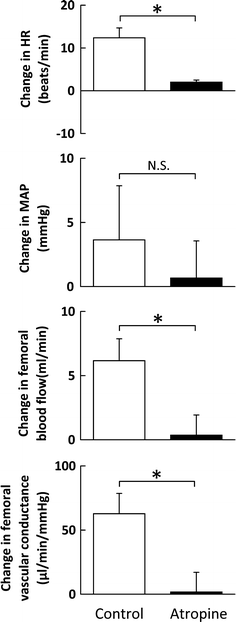Electrical stimulation of the mesencephalic ventral tegmental area evokes skeletal muscle vasodilatation in the cat and rat
- PMID: 21541811
- PMCID: PMC10717621
- DOI: 10.1007/s12576-011-0149-8
Electrical stimulation of the mesencephalic ventral tegmental area evokes skeletal muscle vasodilatation in the cat and rat
Abstract
To test the hypothesis that the mesencephalic ventral tegmental area (VTA) plays a role in autonomic control of the cardiovascular system, we examined the cardiovascular effects of electrical stimulation of the mesencephalic ventral areas in anesthetized, paralyzed cats and rats. Electrical stimulation of the VTA for 30 s (100-μA current intensity; 40-50-Hz pulse frequency; 0.5-1-ms pulse duration) increased femoral blood flow by 130-162% in anesthetized cats and rats, whereas the identical stimulation of the substantial nigra (SN) failed to increase femoral blood flow. Electrical stimulation of the VTA also increased the arterial blood pressure and heart rate in anesthetized rats, but did not alter them in anesthetized cats. Accordingly, femoral vascular conductance was increased by 102-134% in both cats and rats. Atropine methyl nitrate (0.1 mg/kg) injected intravenously in the cats markedly attenuated the increases in femoral blood flow and vascular conductance. VTA stimulation was able to produce substantial increases in femoral blood flow and vascular conductance following a decerebration procedure performed at the premammillary and precollicular level in the cats, although their responses tended to attenuate to 55-69% of the control before the decerebration. Thus, it is likely that electrical stimulation of the VTA, but not the SN, is capable of evoking skeletal muscle vasodilatation, particularly via a sympathetically mediated cholinergic mechanism in the cat, and that the ascending projection from the VTA to the forebrain may not be responsible for the muscle vasodilatation.
Figures





Similar articles
-
Stimulation of the mesencephalic ventral tegmental area blunts the sensitivity of cardiac baroreflex in decerebrate cats.Auton Neurosci. 2015 May;189:16-24. doi: 10.1016/j.autneu.2014.12.005. Epub 2015 Jan 3. Auton Neurosci. 2015. PMID: 25600884
-
Coactivation of renal sympathetic neurons and somatic motor neurons by chemical stimulation of the midbrain ventral tegmental area.J Appl Physiol (1985). 2011 May;110(5):1342-53. doi: 10.1152/japplphysiol.01233.2010. Epub 2011 Mar 10. J Appl Physiol (1985). 2011. PMID: 21393462
-
Sympathetic cholinergic nerve contributes to increased muscle blood flow at the onset of voluntary static exercise in conscious cats.Am J Physiol Regul Integr Comp Physiol. 2008 Oct;295(4):R1251-62. doi: 10.1152/ajpregu.00076.2008. Epub 2008 Aug 13. Am J Physiol Regul Integr Comp Physiol. 2008. PMID: 18703415
-
Direct observations of sympathetic cholinergic vasodilatation of skeletal muscle small arteries in the cat.J Physiol. 1997 Apr 1;500 ( Pt 1)(Pt 1):213-25. doi: 10.1113/jphysiol.1997.sp022011. J Physiol. 1997. PMID: 9097945 Free PMC article.
-
Sympathetic vasodilatation in human limbs.J Physiol. 2000 Aug 1;526 Pt 3:471-80. J Physiol. 2000. PMID: 10922000 Review.
Cited by
-
Striatal Dopamine and Skeletal Muscle Energy Metabolism in Older Adults.medRxiv [Preprint]. 2025 Jun 12:2025.06.12.25329490. doi: 10.1101/2025.06.12.25329490. medRxiv. 2025. PMID: 40585073 Free PMC article. Preprint.
-
Evaluation of GABA Receptors of Ventral Tegmental Area in Cardiovascular Responses in Rat.Iran J Med Sci. 2014 Jul;39(4):374-81. Iran J Med Sci. 2014. PMID: 25031490 Free PMC article.
-
Exaggerated sympathetic and cardiovascular responses to stimulation of the mesencephalic locomotor region in spontaneously hypertensive rats.Am J Physiol Heart Circ Physiol. 2016 Jan 1;310(1):H123-31. doi: 10.1152/ajpheart.00479.2015. Epub 2015 Nov 6. Am J Physiol Heart Circ Physiol. 2016. PMID: 26545711 Free PMC article.
-
Regulation of increased blood flow (hyperemia) to muscles during exercise: a hierarchy of competing physiological needs.Physiol Rev. 2015 Apr;95(2):549-601. doi: 10.1152/physrev.00035.2013. Physiol Rev. 2015. PMID: 25834232 Free PMC article. Review.
-
Central command increases muscular oxygenation of the non-exercising arm at the early period of voluntary one-armed cranking.Physiol Rep. 2017 Apr;5(7):e13237. doi: 10.14814/phy2.13237. Physiol Rep. 2017. PMID: 28381448 Free PMC article.
References
-
- Haber SN, Fudge JL. The primate substantia nigra and VTA: integrative circuitry and function. Crit Rev Neurobiol. 1997;11:323–342. - PubMed
-
- van Domburg PH, ten Donkelaar HJ. The human substantia nigra and ventral tegmental area. A neuroanatomical study with notes on aging and aging diseases. Adv Anat Embryol Cell Biol. 1991;121:1–132. - PubMed
Publication types
MeSH terms
Substances
LinkOut - more resources
Full Text Sources
Miscellaneous

